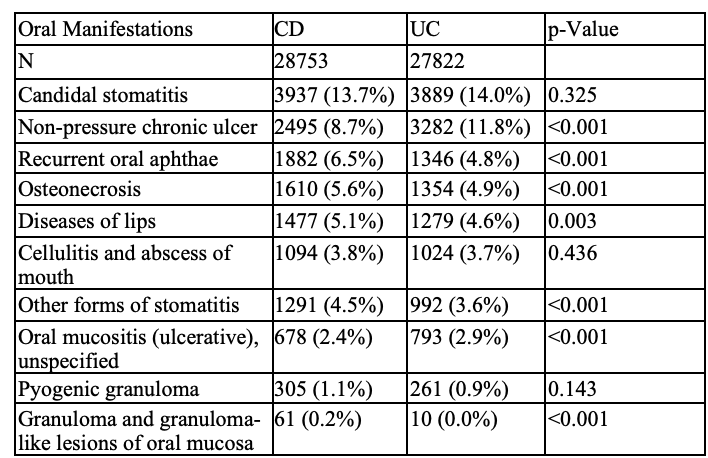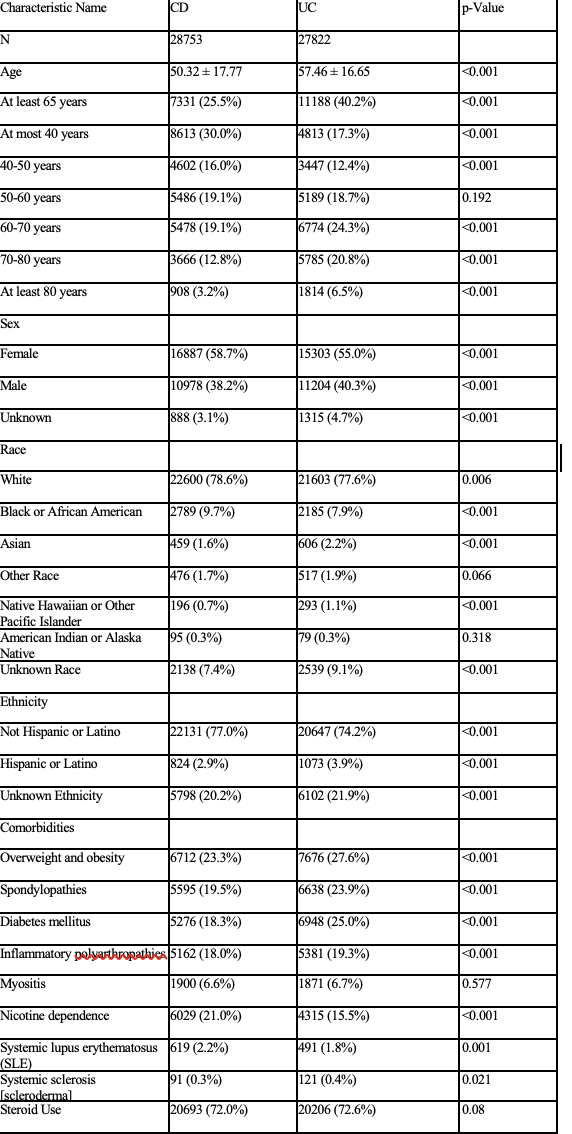Monday Poster Session
Category: IBD
P3341 - Epidemiology of Oral Manifestations in Inflammatory Bowel Disease: A Retrospective Cohort Study
Monday, October 27, 2025
10:30 AM - 4:00 PM PDT
Location: Exhibit Hall
- SS
Sahil Sethi, DO
University Hospitals Cleveland Medical Center, Case Western Reserve University
Cleveland, OH
Presenting Author(s)
Sahil Sethi, DO1, Elleson Harper, BS1, Jaime A. Perez, PhD1, Gregory S. Cooper, MD2, Preetika Sinh, MD3, Jeffery Katz, MD1, Fabio Cominelli, MD, PhD1, Miguel Regueiro, MD4, Emad Mansoor, MD1
1University Hospitals Cleveland Medical Center, Case Western Reserve University, Cleveland, OH; 2Digestive Health Institute, University Hospitals Cleveland Medical Center, Cleveland, OH; 3Medical College of Wisconsin, Cleveland, OH; 4Cleveland Clinic, Cleveland, OH
Introduction: The presence of orofacial symptoms are common in patients with inflammatory bowel disease (IBD). They can present as a primary manifestation of the disease within the oral cavity, or as a secondary manifestation of the disease from either IBD-related conditions or a side effect from medications used in treatment. This study aims to determine the prevalence of various oral manifestations in CD vs UC overall, and prevalence stratified by age, race, and sex.
Methods: We used TriNetX, a de-identified health research platform representing more than 150 million patients. We identified all adult patients (≥ 18 years) with 2 instances of diagnosis of CD or UC. For all patients, we collected available data on patient demographics, comorbid conditions, and diagnoses related to oral manifestations. We conducted independent t-tests for continuous data (reported as means and standard deviations) and chi-square tests for categorical data (reported as frequencies and percentages). All tests were two-tailed, with an alpha level set at 0.05.
Results: We identified 188,027 patients with CD and 171,136 patients with UC. Of patients with CD, 15.2% were diagnosed with an oral manifestation, while 16.2% UC patients were diagnosed with an oral manifestation. Of patients with an oral manifestation, 69.3% occurred after the diagnosis of CD and 63.2% after the diagnosis of UC.
Mean age of diagnosis was >45 years, UC (age 57.46 ± 16.6) and CD (age 50.32 ± 17.7). Most patients with UC and oral manifestations were diagnosed after age 65 (40.2%). Those with CD and oral manifestations were diagnosed at 40 years or younger (30%).
The most prevalent oral manifestation in CD and UC was candidal stomatitis (13.7% in CD, 14.0% in UC), followed by chronic oral ulcers (8.7% in CD, 11.8% in UC).
Steroid use had the highest prevalence (72% in CD, 72.6% in UC) in individuals with oral manifestations and IBD. Other significant comorbidities in this population include diabetes mellitus, obesity, a nd nicotine dependence.
Discussion: Our study shows that those diagnosed with an oral manifestation in UC occurred at a later age compared to patients with CD. It highlights that these oral manifestations were more likely to be found in white patients than non-white patients. The most common oral manifestations were candidal stomatitis, chronic oral ulcers and recurrent oral aphthae. Our study highlights that steroid use, especially in those with UC, is associated with developing an oral manifestation in IBD.

Figure: Table 1. Baseline characteristics of patients with oral manifestations, stratified by Crohn’s (CD) of Ulcerative colitis (UC) diagnosis.

Figure: Table 2. Prevalence of oral manifestations in patients with Crohn’s (CD) or Ulcerative colitis (UC)
Disclosures:
Sahil Sethi indicated no relevant financial relationships.
Elleson Harper indicated no relevant financial relationships.
Jaime Perez indicated no relevant financial relationships.
Gregory Cooper indicated no relevant financial relationships.
Preetika Sinh indicated no relevant financial relationships.
Jeffery Katz indicated no relevant financial relationships.
Fabio Cominelli indicated no relevant financial relationships.
Miguel Regueiro: AbbVie – Advisory Committee/Board Member, Consultant. Amgen – Advisory Committee/Board Member, Consultant. BMS – Advisory Committee/Board Member, Consultant. Boehringer Ingelheim Pharmaceuticals Inc. – Advisory Committee/Board Member, Consultant. Celegene – Advisory Committee/Board Member, Consultant. Eli Lilly and Company – Advisory Committee/Board Member, Consultant. Genentech – Advisory Committee/Board Member, Consultant. Gilead – Advisory Committee/Board Member, Consultant. Janssen – Advisory Committee/Board Member, Consultant. Organon – Advisory Committee/Board Member, Consultant. Pfizer – Advisory Committee/Board Member, Consultant. Prometheus – Advisory Committee/Board Member, Consultant. Salix – Advisory Committee/Board Member, Consultant. Takeda – Advisory Committee/Board Member, Consultant. UCB – Advisory Committee/Board Member, Consultant.
Emad Mansoor: Lilly – Speakers Bureau. Takeda – Speakers Bureau.
Sahil Sethi, DO1, Elleson Harper, BS1, Jaime A. Perez, PhD1, Gregory S. Cooper, MD2, Preetika Sinh, MD3, Jeffery Katz, MD1, Fabio Cominelli, MD, PhD1, Miguel Regueiro, MD4, Emad Mansoor, MD1. P3341 - Epidemiology of Oral Manifestations in Inflammatory Bowel Disease: A Retrospective Cohort Study, ACG 2025 Annual Scientific Meeting Abstracts. Phoenix, AZ: American College of Gastroenterology.
1University Hospitals Cleveland Medical Center, Case Western Reserve University, Cleveland, OH; 2Digestive Health Institute, University Hospitals Cleveland Medical Center, Cleveland, OH; 3Medical College of Wisconsin, Cleveland, OH; 4Cleveland Clinic, Cleveland, OH
Introduction: The presence of orofacial symptoms are common in patients with inflammatory bowel disease (IBD). They can present as a primary manifestation of the disease within the oral cavity, or as a secondary manifestation of the disease from either IBD-related conditions or a side effect from medications used in treatment. This study aims to determine the prevalence of various oral manifestations in CD vs UC overall, and prevalence stratified by age, race, and sex.
Methods: We used TriNetX, a de-identified health research platform representing more than 150 million patients. We identified all adult patients (≥ 18 years) with 2 instances of diagnosis of CD or UC. For all patients, we collected available data on patient demographics, comorbid conditions, and diagnoses related to oral manifestations. We conducted independent t-tests for continuous data (reported as means and standard deviations) and chi-square tests for categorical data (reported as frequencies and percentages). All tests were two-tailed, with an alpha level set at 0.05.
Results: We identified 188,027 patients with CD and 171,136 patients with UC. Of patients with CD, 15.2% were diagnosed with an oral manifestation, while 16.2% UC patients were diagnosed with an oral manifestation. Of patients with an oral manifestation, 69.3% occurred after the diagnosis of CD and 63.2% after the diagnosis of UC.
Mean age of diagnosis was >45 years, UC (age 57.46 ± 16.6) and CD (age 50.32 ± 17.7). Most patients with UC and oral manifestations were diagnosed after age 65 (40.2%). Those with CD and oral manifestations were diagnosed at 40 years or younger (30%).
The most prevalent oral manifestation in CD and UC was candidal stomatitis (13.7% in CD, 14.0% in UC), followed by chronic oral ulcers (8.7% in CD, 11.8% in UC).
Steroid use had the highest prevalence (72% in CD, 72.6% in UC) in individuals with oral manifestations and IBD. Other significant comorbidities in this population include diabetes mellitus, obesity, a nd nicotine dependence.
Discussion: Our study shows that those diagnosed with an oral manifestation in UC occurred at a later age compared to patients with CD. It highlights that these oral manifestations were more likely to be found in white patients than non-white patients. The most common oral manifestations were candidal stomatitis, chronic oral ulcers and recurrent oral aphthae. Our study highlights that steroid use, especially in those with UC, is associated with developing an oral manifestation in IBD.

Figure: Table 1. Baseline characteristics of patients with oral manifestations, stratified by Crohn’s (CD) of Ulcerative colitis (UC) diagnosis.

Figure: Table 2. Prevalence of oral manifestations in patients with Crohn’s (CD) or Ulcerative colitis (UC)
Disclosures:
Sahil Sethi indicated no relevant financial relationships.
Elleson Harper indicated no relevant financial relationships.
Jaime Perez indicated no relevant financial relationships.
Gregory Cooper indicated no relevant financial relationships.
Preetika Sinh indicated no relevant financial relationships.
Jeffery Katz indicated no relevant financial relationships.
Fabio Cominelli indicated no relevant financial relationships.
Miguel Regueiro: AbbVie – Advisory Committee/Board Member, Consultant. Amgen – Advisory Committee/Board Member, Consultant. BMS – Advisory Committee/Board Member, Consultant. Boehringer Ingelheim Pharmaceuticals Inc. – Advisory Committee/Board Member, Consultant. Celegene – Advisory Committee/Board Member, Consultant. Eli Lilly and Company – Advisory Committee/Board Member, Consultant. Genentech – Advisory Committee/Board Member, Consultant. Gilead – Advisory Committee/Board Member, Consultant. Janssen – Advisory Committee/Board Member, Consultant. Organon – Advisory Committee/Board Member, Consultant. Pfizer – Advisory Committee/Board Member, Consultant. Prometheus – Advisory Committee/Board Member, Consultant. Salix – Advisory Committee/Board Member, Consultant. Takeda – Advisory Committee/Board Member, Consultant. UCB – Advisory Committee/Board Member, Consultant.
Emad Mansoor: Lilly – Speakers Bureau. Takeda – Speakers Bureau.
Sahil Sethi, DO1, Elleson Harper, BS1, Jaime A. Perez, PhD1, Gregory S. Cooper, MD2, Preetika Sinh, MD3, Jeffery Katz, MD1, Fabio Cominelli, MD, PhD1, Miguel Regueiro, MD4, Emad Mansoor, MD1. P3341 - Epidemiology of Oral Manifestations in Inflammatory Bowel Disease: A Retrospective Cohort Study, ACG 2025 Annual Scientific Meeting Abstracts. Phoenix, AZ: American College of Gastroenterology.

